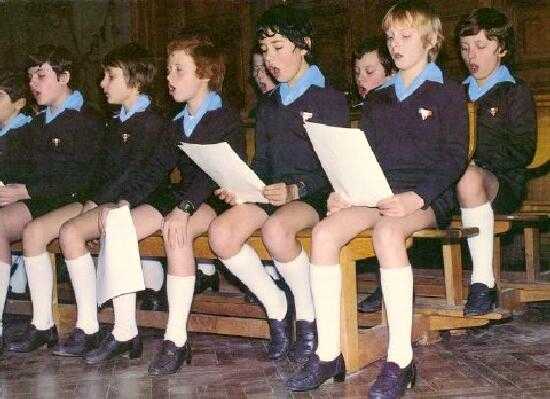
Petits Chanteurs ŕ la Croix de Bois Uniform: Garments

Figure 1.--The PCCB uses a school uniform type costume for both a school and a travel uniform. They also give secular concerts in the uniform. Here we see the choristers practing at Glaignes about 1980. During their performances they never use score pages. They have to memorize many chants. Even the soloist doesn't used score sheets.
|
|
The current PCCB uniform was adopted in 1943 during World War II. The uniform included several different garments, most of which have remained unchanged for many years. One of the few changes is that the beret has been dropped. The length of the short pants has also changed over time. The boys have worn knee socks from the beginning, but we notice that they changed from dark (resumably blue) knee sicks to white knee socks.
Photographs from the 1950s show the PCCB choristers wearing berets with their school and choir uniform. The berets were presumably worn on trips and when going and coming to school. I am not sure if the beret's were blue or black. We know the berets were also worn in te 1930s and 40s, but I am not sure about earlier. By the 1950s the beretwas no longer considered stylish in France, but on international trips they porobably made the boys look more French. The berets were quite large ones and had the choir crest on the berets. The berets were discontinued, probaly in the 1960s.
Coats
One photograph shows the PCCB choristers wearing heavy, presumably blue, coats. It looks to be the 1950s. We are not sure if they still wear these coats during the winter.
Sweaters
The PCCB choristers wear long-sleeved, "V" neck sweaters. "V" neck sweater are usually worn with ties, but the choristers do not wear ties.
Shirts
The boys wear open-necked regular dress light-blue shirts.
Short Pants
The boys wear dark blue short pants. One of the few changes in the uniform over time has been the length of the shorts. This has varied along with the prevailing fashion of the day. A HBC contributor comments, "Notice how long the shorts are in comparison to the more traditional short pants. The pants length
looks more like early 1900s than 1940s." HBC agrees that shorts were quite long in the 1900s when they began replacing kneepants. However long shorts like these are the style for short pants in France and several other European countries in the 1990s. Boys in the 1900s would not have worn shorts with white kneesocks. HBC does begin noting shorts and white kneesocks in France after World War I in the 1920s. Photographs of French choir boys dating to the 1940s show them wearing blue shorts and white knee socks. HBC is unsure, however, precisely just when this uniform was introduced. A reader writes, "Their short pants length changed over the years to suit the fashion of the day. From this, can we say that! institutions like these listened to the preferences of their members, and that they had a say in what uniforms they wore? Since boys prefer long pants over short pants these days, which is likely to prevail (from historical experiences) - tradition or fashion?" A former chorister tells us, "The PCCB Institution keeps from ever its traditions. This way likes much to
the public. By instance, this is only a boy choir, we can't change its uniform. But the alb has changed in 1980 by a modern one. A the reader mentions, the length of their short pants has changed a bit over the time
to suit the fashion. I must say, as member of the PCCB Administration, I know that the boys and their Parents are proud about the uniform."
We do not know what the hosiery was in the early years, but assume it was knee socks. we notice images of the boys just before World War II in the 1930s wearing dark knee socks. They look like Scout knee socks with bands at the knee cuff. After the War the boys began wearing white knee socks.
The boys wear white knee socks. British boys rarely wore white knee socks. They were commonly worn by British girls, but not the boys. And this was the case with British choirs. The conventions wee different on the Continent. Both French and German boy did wear white knee socks, including the boys in choirs. For PCCB performances little details such as having the socks pulled up to their knees are carefully checked.
Shoes
The boys wear black, lace-up shoes.
Pins
The choristers wear pins on their blue sweaters. The pin is a red white and blue xstyalized French flag with a cross offset below the wjite segment.
HBC

Navigate the Historic Boys' Clothing Web Site:
[Return to the Main PCCB school uniform type-uniform ]
[Introduction]
[Activities]
[Biographies]
[Chronology]
[Clothing styles]
[Countries]
[Bibliographies]
[Contributions]
[FAQs]
[Glossaries]
[Images]
[Links]
[Registration]
[Tools]
[Boys' Clothing Home]
Navigate the Historic Boys' Clothing Web choir costume pages:
[Return to the Main French choir page]
[Return to the Main national choir page]
[Australia]
[Austria]
[Belgium]
[Bulgaria]
[Canada]
[Denmark]
[England]
[France]
[Finland]
[Germany]
[Japan]
[Netherlands]
[Poland]
[South Africa]
[United States]
Navigate the Historic Boys' Clothing Web style pages:
[Short pants suits]
[Blazers]
[Collars]
[Lace collars]
[Ruffled collars]
[Eton collar]
[Fauntleroy suits]
[Sailor suits]
[Ring bearer/page costumes]
[First Communion suits]
Created: 10:39 PM 8/3/2005
Last updated: 4:15 AM 3/21/2012



